
![]()
Search the Journey to Forever website – click HERE
|
Journey to Forever: Make a donation |
Navigation
| Trees, soil and water |
| In the news |
| Not in the news |
| References and resources |
| Trees for deserts: HDRA |
| Trees and forests -- resources for schools |
Contact usTo Keith Addison Handmade Projects |
Trees for deserts
Overseas Projects
Henry Doubleday Research Association -- Britain's National Organic Gardening Association, Annual Report 1990
Written and produced by Keith Addison
The HDRA has assisted hundreds of projects in Third World countries, helping to plant millions of drought-resistant trees -- at a cost of less than a penny a tree.
 The continuing succession of famines in drought-stricken Africa seem the act of a vengeful God. Millions of people are at risk. Global appeals fight to get food to the emaciated hordes that pour out of the devastated lands and onto the world's television screens. No-one knows how many lives have been lost. Some campaigns have promised to end famines once and for all -- until the next mass tragedy unfolds. The problem seems intractable.
The continuing succession of famines in drought-stricken Africa seem the act of a vengeful God. Millions of people are at risk. Global appeals fight to get food to the emaciated hordes that pour out of the devastated lands and onto the world's television screens. No-one knows how many lives have been lost. Some campaigns have promised to end famines once and for all -- until the next mass tragedy unfolds. The problem seems intractable.
It is certainly complex, with no quick-fix solutions. It is also a truly ancient problem, and we should have seen it coming. In fact we did: "Destruction of the earth's thin living cover is proceeding at a rate and on a scale unparalleled in history, and when that thin cover -- the soil -- is gone, the fertile regions where it formerly lay will be uninhabitable deserts," wrote Jacks and Whyte more than 60 years ago in The Rape of the Earth: A World Survey of Soil Erosion. They continued: "The threat of a succession of man-made deserts is a very real one to all parts of Africa."
Today, the deserts are spreading at the rate of five million hectares a year worldwide (not yet quite as fast as the rainforests are vanishing), with a third of the world's land surface at risk from desertification -- an area larger than the whole continent of Africa.
'After the man the desert'
A potent mixture of economic pressures, modern agricultural practises and population growth have forced Third World farmers to fell tree cover to grow grains, forced farms into marginal areas and up steep slopes, forced herders into ever-smaller grazing areas. The last trees fall to the desperate need for firewood. The soil washes away with the rain, and neither are seen again. Crop-failure, famine.
The American researcher J. Russell Smith charted the process in four words: "Forest -- field -- plough -- desert". He also charted how this disastrous progression could be reversed, by using special trees. "When we develop an agriculture that fits the land, it will become an almost endless vista of green, crop-yielding trees," he wrote.
"The world needs experiment stations whose staffs are experts in the breeding of drought-resisting trees." -- J. Russell Smith (Tree Crops -- A Permanent Agriculture, 1929)
That agriculture must "fit the land" is a basic organic concept. The conviction that encroaching deserts can be pushed back is at the heart of the HDRA's overseas work.
In 1986, in the wake of the Ethiopian famine, the HDRA set up the Drought Defeaters Project to investigate long-term solutions to some of the problems of drought and desertification. It was obvious that grain was needed in the short term, but that the people would never be able to feed themselves until the trend of tree-felling and soil loss could be reversed.
Desert trees
The project developed out of an interest in the extraordinary capacity of some trees to tolerate arid conditions. Prosopis trees, for instance, live in deserts.
Although it is a group of islands in the Atlantic Ocean, Cape Verde is in the sub-Saharan climatic zone and suffers the same conditions. There hasn't really been a rainy season for decades.
The closest truly arid conditions to Britain are to be found in Spain, where the HDRA is collaborating in a tree research program with a research centre set in the foothills of the Sierra Nevada. Hundreds of trees have been planted out and promising species selected for further trials, along with new species, including local trees. The HDRA is working with Durham University on projects to conserve and investigate woodlands in the Wahiba Sands Desert of Oman, where communities of Prosopis cineraria and Acacia tortilis trees survive with little or no rainfall. This species of Prosopis yields useful timber and excellent firewood, the leaves make nutritious fodder for livestock, the pods are good fodder and also serve as a vegetable for humans, the flowers support honey production, and the bark can be used in leather tanning and yields an edible gum -- all on less then 75mm of rain and an eight-month dry season. In 1990 the HDRA started working with Sultan Qaboos University in evaluating local drought-resistant tree species in some of the driest areas available. The HDRA supports projects in India, Sri Lanka and Nepal, and in 1990 we began collaborating with two universities in North West India in investigating drought-resistant trees in the Thar Desert, mainly Prosopis cineraria. In 1988 the HDRA began a collaborative laboratory and field research project with Shandong Teachers University in China on revegetation of an area of some 7,000 square kilometres in the Yellow River Delta, where the problem is not only desert conditions but saline soils. The project involves exchanges of English and Chinese researchers. Work is progressing well, with interplanting of amaranthus grain and other crops and trees. This work is relevant to other arid areas in temperate regions. The HDRA is now collaborating with the University of Western Australia, which has been doing similar work with drought-resistant Australian species. HDRA Overseas Projects has been strongly supported by HDRA members -- regular donors who have stood by us from the very early days. The Drought Defeaters Project has also been funded by Comic Relief, Men of the Trees and the Overseas Development Administration (ODA). A large grant from the Forestry Research Program of the ODA will support the work in Oman and Cape Verde from 1991. The three-year collaboration with Shandong Teachers University in China has been extended to 1994. The HDRA's work with desert trees is to be extended with a new project to develop organic cropping systems in tropical agriculture.
Prosopis in Cape Verde -- Comparative physiology, field performance and propagation of Prosopis 1989-1995 (DFID). HDRA carried out six years of intensive research with the government of Cape Verde, to test the ability for different Prosopis species to withstand water, wind and salinity stresses. Unfortunately the trees planted prior to HDRA's project all originated from a small introduction, thus were genetically very similar, laying the tree population open to the spread of disease and pests. Through the research carried out, several species, not previously cultivated on the islands, have proven successful in the re-afforestation of inland areas suffering from extreme drought and have thus facilitated species diversification. Establishment of a living collection of nitrogen fixing trees in the Republic of Cape Verde. Harris PJC, Sandys-Winsch DC and Hyde EA (1990) Nitrogen Fixing Tree Research Reports 8: 67-68. The Neem Tree - 20 pages (PDF 238Kb) Trees, soil and water
They need almost no water, they grow rapidly and soon yield crops of firewood, they provide excellent forage for livestock, and they can be used to stop soil erosion. The HDRA had funded laboratory and greenhouse studies of such trees at three British universities, which had confirmed the drought tolerance of many potentially useful tree species.
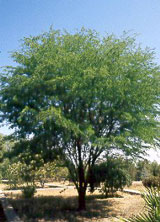
Prosopis tree
We now planned to expand this work into a practical international program. Dr Phil Harris was seconded from Coventry Polytechnic to work at Ryton as the HDRA's Third World Projects Co-ordinator. The strategy followed the basic organic principles we advocate in the UK: it included work on conserving and collecting multipurpose trees and shrubs from arid areas; selecting and propagating the best species and varieties; testing trees and shrubs in sustainable forestry and agroforestry systems in tropical countries; and distributing tree seeds and growing techniques through an international network of development groups.
By 1989 the work had progressed to the point where we could offer practical assistance -- information and advice on selecting tree species for particular locations and purposes, details of recommended cultural practises,
and high-quality seed, tested by the HDRA, in sufficient quantity for practical introduction trials, free of charge, by return of post. These seeds are obtained from commercial suppliers or from collections made by the HDRA and overseas collaborators. Such a package can be of inestimable value to a struggling community.
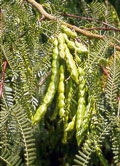
Prosopis pods and leaves
We publicized this service in the leading development and agriculture journals. This brought a tremendous response from the developing world. In 1990 we were taking on two new projects a week.
Since the Tree Seed Distribution Project began in July 1989, we have provided information and advice to 194 projects in 38 African countries and have sent seed of 106 different selected tree species to 110 of these projects -- enough to plant 3,281,952 trees.
Seed for well over a million trees has been provided for agroforestry projects in the Ethiopian Highlands, with excellent results. This has all been achieved at a total cost of £28,038.04 -- less than a penny a tree. We have also assisted 30 projects in Asia, the Pacific and Latin America.
We work with key projects from which the benefits rapidly spread to local subsistence farmers. Of the projects we support, 30% are government extension projects, 47% are run by Non-Government Organizations (both local and international), and the remaining 23% are small projects or single farmers.
Our Overseas Projects staff has swelled from one to nine. Dr Harris's assistants at Ryton are Stephanie Woods and Marianne Sandison.
Coventry Polytechnic, Durham University, Wye College, Imperial College and Kew Gardens have all contributed to the scientific work, and the HDRA also carries out collaborative research projects in the Republic of Cape Verde, the Sultanate of Oman, India, China and Australia.
Cape Verde
The land is denuded and the soil long gone. Reafforestation is a national priority, and has concentrated on Prosopis trees. In 1986 the HDRA began a research collaboration with the Cape Verde National Agricultural Institute (INIA) which continues today. The HDRA has planted some 20,000 test trees and seeds of selected species have been provided for practical programs which have planted millions of trees on the islands, including species which are succeeding in problem areas.
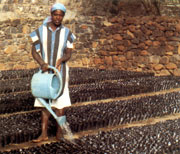
Prosopis seedlings in Cape Verde -- Third World women are the main beneficiaries (HDRA Library)
The HDRA's Dr Claire Winsch left Cape Verde in 1990 after two years and was replaced by Frances Harris.
Spain
Oman
India
"Cineraria is one of the few Old World species of Prosopis," says Dr. Phil Harris. "In Rajasthan and Pakistan, it has been the mainstay of the local economies for thousands of years. This is one of the great traditional agroforestry systems of the world. The people totally rely on the Prosopis tree: they lop it for fodder, they eat the pods, they interplant other crops with it. It tolerates incredibly dry conditions. However, very little has been done to conserve it, and it is threatened by over-population. There is tremendous scope to conserve, investigate and improve the tree, and to extend its use."
HDRA researchers have travelled throughout the range of Prosopis cineraria in India, often travelling by camel or donkey. "They have collected 33 of the most widely different types of this species, so we now have a wide range of germ plasm," says Dr Harris. "These will now be grown out in the Haryana region, a desert area, where we can study the better kinds.
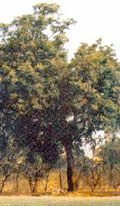
Neem tree in India
"We're also feeding this material to the Cape Verde and Oman projects. The Haryana trials will be duplicated in Oman, and some of the best successions from Oman will then go to India. We expect to end up with a hundred or more radically different collections of the same species in cultivation."
Further work in India involves investigating why the Rajasthan teak, Tecomella undulata, a useful and beautiful desert tree, is not more widely spread than it is, and the secret of the apparent symbiosis found between Prosopis and neem trees on the desert fringes, where they grow together like one composite tree, their trunks touching, their leaves forming a common canopy.
China
Australia
The future
Organic growing in the tropics
"We have long felt that our work in agroforestry projects in developing countries is but one aspect of the organic philosophy," says HDRA Director Jackie Gear. "Organic principles apply universally, from amateur gardening and agriculture in the 'developed' countries through to food production in developing countries. We do not want to see these countries suffering the disastrous consequences of high-input agriculture. They should choose the organic way as the only truly sustainable system.
"Our thinking on this has been confirmed by the hundreds of enquiries we've received from developing countries thirsty for knowledge of organic systems. They cannot afford the high-tech approach, and they know that it causes worse problems than it solves.
"We applied to Comic Relief for a grant to develop organic agricultural cropping systems in developing countries, and we are very happy to report that we have been awarded £48,000 -- half the total funding required. We can now set the project in motion."
-- Written by Keith AddisonReferences
"The Rape of the Earth: A World Survey of Soil Erosion", by G.V. Jacks and R.O Whyte, Faber and Faber, London, 1939.
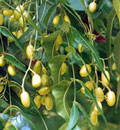
Neem leaves and fruit
"Tree Crops -- A Permanent Agriculture," by J. Russell Smith, Harcourt-Brace, New York, 1929; Devin-Adair, Connecticut, 1950; Island Press Conservation Classics, 1987, ISBN 0-933289-44-0
Resources
http://www.hdra.org.uk/international_programme/
ip_agroforestry_comp_phys.htm
Prosopis juliflora and related arboreal species 1998-2001 (DFID). This study brings together global knowledge on the genus Prosopis on which many rural populations in the form of a monograph and a bibliographic database. An extension manual has also been produced which is targeted at Indian users. Community-based training courses on Prosopis management have been held to improve Prosopis management.
http://www.hdra.org.uk/international_programme/
ip_agroforestry_prosopis.htm
Managing Prosopis juliflora (Vilayati babul): A Technical Manual (2000) Tewari, JC, Harris PJC, Harsh LN, Cadoret K and Pasiecznik NM. CAZRI, Jodhpur, India and HDRA, Coventry, UK. 96pp. ISBN 0 905343 27 1
Download manual (PDF 12.7Mb)
http://www.hdra.org.uk/pdfs/international_programme/
ManagingProsopisManual.pdf
The Prosopis juliflora - Prosopis pallida Complex: A Monograph (2001) Pasiecznik, N.M., Felker, P., Harris, P.J.C., Harsh, L.N., Cruz, G., Tewari, J.C., Cadoret, K. and Maldonado, L.J. HDRA, Coventry, UK. 162pp. ISBN 0 905343 30 1
Download complete monograph (PDF 2,399Kb)
http://www.gardenorganic.org.uk/pdfs/international_programme/
ProsopisMonographComplete.pdf
Identifying Tropical Prosopis Species: A Field Guide (2004) Pasiecznik, NM, Harris, PJC and Smith, SJ. Coventry, UK 30pp ISBN 0 905343 34 4
Download guide (PDF 507Kb)
http://www.gardenorganic.org.uk/pdfs/international_programme/
IdentifyingProsopisGuide.pdf
Prosopis cineraria -- A Multipurpose Tree for Arid Areas M.S. Sandison and P.J.C. Harris, Henry Doubleday Research Association, Ryton-on-Dunsmore, Coventry CV8 3LG, United Kingdom, with contributions from I. Hussain, Rajasthan Agricultural University, Udaipur 313 001, Rajasthan, India, and Nitrogen Fixing Tree Association (NFTA) staff. A publication of the Forest, Farm, and Community Tree Network (FACT Net).
http://www.winrock.org/fnrm/factnet/factpub/FACTSH/P_cineraria.html
Developing Prosopis as a valuable resource for dry zones (2004) -- The Forestry Research Programme of the UK Government's Department for International Development (DFID) has supported HDRA in running a series of research and development projects since 1992, on Prosopis trees for drylands and the people who live there. This is a synthesis of the work and its impacts. Download (PDF 782Kb)
http://www.hdra.org.uk/pdfs/international_programme/
FloridaSynthesis.pdf?www.hdra.org.uk/pdfs/international_programme/
Prosopis-PolicyBrief-1.pdf
Exploiting the value of Prosopis for dryland forestry and agroforestry systems -- A briefing paper for agencies concerned with international research and development. Download (PDF 296Kb)
http://www.hdra.org.uk/pdfs/international_programme/
Prosopis-PolicyBrief-1.pdf
Prosopis juliflora (vilayati babul) in the drylands of India: develop this valuable resource – don't eradicate it -- A briefing paper for the Government of India, state governments and concerned ministries. Download (PDF 192Kb)
http://www.hdra.org.uk/pdfs/international_programme/
Prosopis-PolicyBrief-2.pdf
Prosopis (mesquite, algarrobo): invasive weed or valuable forest resource? -- A briefing paper for local, national and international bodies responsible for natural resource management in arid and semi-arid regions experiencing invasions of weedy Prosopis. Download (PDF 232Kb)
http://www.hdra.org.uk/pdfs/international_programme/
Prosopis-PolicyBrief-3.pdf
Books, reports and briefing papers on prosopis for free download from the HDRA (now Garden Organic UK); also CD and film:
http://www.gardenorganic.org.uk/international_programme/
ip_publications.php#ProsopisPublications
Evaluation of Prosopis and Acacia species for coastal afforestation in the Republic of Cape Verde. Sandys-Winsch DC, Theisen P and Harris PJC (1990) Nitrogen Fixing Tree Research Reports 8: 71-72.
Performance of Prosopis and Acacia species at an arid site in the Republic of Cape Verde. Sandys-Winsch DC, Theisen P and Harris PJC (1991) Nitrogen Fixing Tree Research Reports 9: 56-58.
The effects of season, soil salinity and wind on foliage loss from Acacia and Prosopis species at a coastal site in the Republic of Cape Verde. Sandys-Winsch DC and Harris PJC (1991) Nitrogen Fixing Tree Research Reports 9: 58-61.
A simple method for the vegetative propagation of Prosopis juliflora. Sandys-Winsch DC and Harris PJC (1991) Nitrogen Fixing Tree Research Reports 9: 117-118.
Forestry and agroforestry in the Cape Verde Islands. Sandys-Winsch DC and Harris PJC (1992) Agroforestry Systems 19: 79-91.
Growth of Prosopis and Acacia species and their effects on soil fertility. Pasiecznik NM, Harris FMA and Harris PJC (1993) Nitrogen Fixing Tree Research Reports 11, 1-3.
Prosopis species; Aspects of Their Value, Research and Development, Proceedings of the Prosopis Symposium, University of Durham, 27-31 July 1992, CORD, Durham. Harris PJC (1993) Vegetative propagation of Prosopis. pp. 175-192. In: Dutton RW (ed).
Green development on the Cape Verde Islands. Sandys-Winsch DC and Harris PJC (1994) Environmental Conservation 21: 225-230.
Prosopis: an under-exploited forestry resource. Harris PJC, Bradbury M, Pasiecznik NM and Arya S (1994) Science and Technology Now 5, 14-17.
Prosopis juliflora withstands extreme aridity and goat browsing in the Republic of Cape Verde. Pasiecznik NM, Vera Cruz MT and Harris PJC (1995) Nitrogen Fixing Tree Reports 13.
Prosopis genetic improvement trials in Cape Verde. Harris PJC, Pasiecznik NM, Vera-Cruz MT and Bradbury M (1996) Pp. 4-4 - 4-20 In: Felker P (ed.). Prosopis: Semi-arid fuelwood and forage tree; building consensus for the disenfranchised. Washington DC 13-15 March 1996.
The current status of Atriplex on the Cape Verde Islands. Pasiecznik NM, Vera-Cruz MT, Sandys-Winsch DC and Harris PJC (1996) Journal of Arid Environments 34: 507-519.
Problems and potential of Prosopis. Harris PJC, Pasiecznik NM, Bradbury M and Ramirez L (1998) Pp 277-293 In, Prendergast HDV, Etkin NL, Harris DR and Houghton PJ (eds.), Plants for Food and Medicine. Royal Botanic Gardens Kew.
Pretreatment of Prosopis seeds to break dormancy. Pasiecznik NM, Harris PJC, Tavares, JdeP and Cassamá M (1998) International Tree Crops Journal 9: 187-193.Other resources
http://www.gardenorganic.org.uk/pdfs/
international_programme/NeemTree.pdf
Moringa oleifera: a multi-purpose tree - 16 pages (PDF 371Kb)
http://www.gardenorganic.org.uk/pdfs/
international_programme/Moringa.pdf
Agroforestry in the Tropics - 20 pages (PDF 147Kb)
http://www.gardenorganic.org.uk/pdfs/
international_programme/Agrofor02.pdf
Raising Firewood and Fodder Trees in Nurseries - 24 pages (PDF 190Kb)
http://www.gardenorganic.org.uk/pdfs/
international_programme/RaiseFire.pdf
Planting out firewood and fodder species - 16 pages (PDF 381Kb)
http://www.gardenorganic.org.uk/pdfs/
international_programme/Firewood.pdf
HDRA, Britain's organic gardening association, now Garden Organic:
http://www.gardenorganic.org.uk/
How-to guides and Factsheets on organic gardening, composting, pest control -- including "What to do in the garden now" and advice by email. http://www.gardenorganic.org.uk/about_us/whatwedo.php
The Schools Organic Network, launched in January 2000, to introduce children to the pleasures of sowing, planting, growing, nurturing and eventually harvesting the food to eat, using organic methods. Practical help for schools, with everything related to the curriculum. "Today's children could be forgiven for thinking that bananas come from boxes, peas come frozen in packets, and tomatoes from tins. The real origin of these foods -- that they come from living plants which grow in the soil -- is not apparent."
http://www.gardenorganic.org.uk/schools_organic_network/index.php
In the news
Not in the news
References and resources
Trees for deserts: HDRA
Trees and forests -- resources for schools